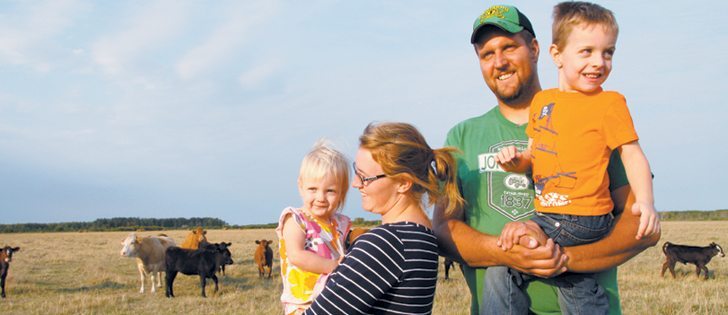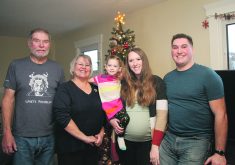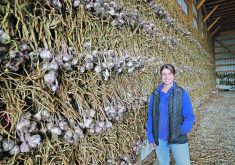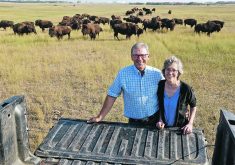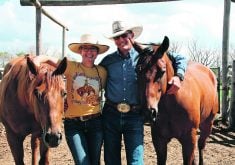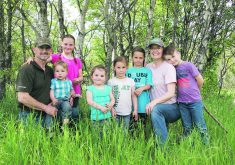LA BROQUERIE, Man. — In some parts of the world, it’s customary for the groom to offer a dowry of cattle, goats or sheep to win the hand of a prospective bride.
For Richard and Kristy-Layne Carr, that old world custom was reversed.
“When I married Kristy-Layne, I got the opposite of a dowry. She came with 30 cows. I didn’t have to give up any cows,” said Richard from inside his farmhouse near La Broquerie, Man.
Kristy-Layne didn’t have a chance to laugh at their unusual engagement tale because she was at work in La Broquerie, where she manages the Seine-Rat River conservation District in southeastern Manitoba.
Read Also

Nutritious pork packed with vitamins, essential minerals
Recipes for pork
Thirty minutes later, she arrived with their two children, Slade, 4, and Elora, 18 months.
Richard, 32, and Kristy-Layne, 30, explained that her parents, who run a cattle farm near Portage la Prairie, Man., provided the dowry to help the newly married couple get started in farming in 2006.
However, running a beef cattle herd isn’t how Richard envisioned his life growing up around Steinbach and La Broquerie.
“I’m a born and raised dairy farmer. My family farmed in England and they moved to Canada to dairy farm,” said Richard, who wore a John Deere shirt and a Farmer’s Feed Families hat this day. “I love cattle, in general, but dairying is my ultimate thing. I did 4-H dairy for years and years showing dairy cattle all over Western Can-ada.”
To fulfill his ambition of running a dairy, Richard applied to the Dairy Farmers of Manitoba young entrants program.
The plan was to run a dairy and have a small herd of beef cattle on the side, but the young couple couldn’t assemble the necessary finances to start the dairy.
Instead, the Carrs decided to expand their beef cattle herd after a house and land became available near La Broquerie.
“We had 30 cows for five years. We had a quarter section of land and 30 cows. It was a more of a hobby to begin with,” said Richard, while Elora and Slade played inside the cab of an old pick-up truck.
“We (now run) 120 cows and we also run 150 replacement heifers. I buy replacement heifers each spring, get them bred and resell them each year.”
In addition to the cattle, which are grass-fed, the Carrs raise pastured poultry and this summer bought seven Berkshire sows and a small herd of piglets, which they plan to raise outside.
They also direct market their meat and Richard delivers steaks, chickens and pork loins to customers in Winnipeg a few times each month.
The Carrs decided to diversify beyond cattle because they hope to sell an array of protein directly to consumers.
“It’s one more thing to market…. If someone calls me, I can hopefully take care of all of their meat needs,” Richard said.
While the Carrs have enlarged their farm operation to owning and renting 1,000 acres of pasture, they haven’t given up their day jobs.
Richard has worked at La Bass Holsteins for the last 12 years, but recently reduced his workload to 30 to 35 hours per week so he could dedicate more time to his own farm.
He works at the dairy until noon then spends the rest of his day feeding the pigs and chickens and moving cattle for rotational grazing.
Nevertheless, Richard takes a light-hearted approach to his frenzied work schedule and the responsibility of raising two children under five.
“It’s definitely a juggling act. I could join any circus.”
When asked why they decided to farm, the Carrs said they want their kids to grow up on a working farm.
“I remember as a kid you were never really bored. You always went out and did something,” said Kristy-Layne, standing next to an outdoor pig pen, as piglets squealed and sows grunted, rooting around for feed.
“We built a fort in the trees or made something out of wood…. I like that and I like that they (our children) can be incorporated into what we do (on the farm).”
If there is work to do on the farm, the Carrs include their children in the action.
“We’ll go check the cows as a family… we try to make the farm life enjoyable,” Richard said.
After committing to a life as a livestock producer, Richard accepted that everything happens for a reason. His dream of operating a dairy farm wasn’t meant to be, so this alternative is the right life for him and his family.
“It’s blessing in a way that it didn’t happen…. I’ve learned to love the beef cows just as much as the dairy.”
Looking ahead, the Carrs aren’t sure if they will expand their herd, but they would like to dedicate more time to direct marketing their meat.
“Instead of finishing only 10 percent of my calves for the grass-fed (beef market), finish 30 percent then maybe 50 (percent),” Richard said. “Our meat sales are still the smallest portion of what we do, but it’s our biggest goal.”
The Carrs’ approach to agriculture is a mix of pragmatism and philosophy.
“Raising hogs outside in a natural setting is different. It obviously makes for a different product. But it doesn’t have the overhead cost of a big barn,” said Richard, who buys all his feed.
“Starting when we did, in the middle of BSE, you learn how to do things cost efficient…. I’ve got two tractors and one doesn’t really run anymore. I’ve got the one tractor, a bale processor, a cattle trailer and a truck. That’s all I really need.”
The Carrs support the idea of locally raised, natural food, but they take a balanced approach.
“We’ve definitely been influenced by Food Inc. and things like that,” said Kristy-Layne, who has a master’s degree from North Dakota State University in animal and range science.
“Economies of scale make sense, with how many people that need to be fed. But there are people interested in getting their food naturally raised, so that’s the people (we’re targeting).”




